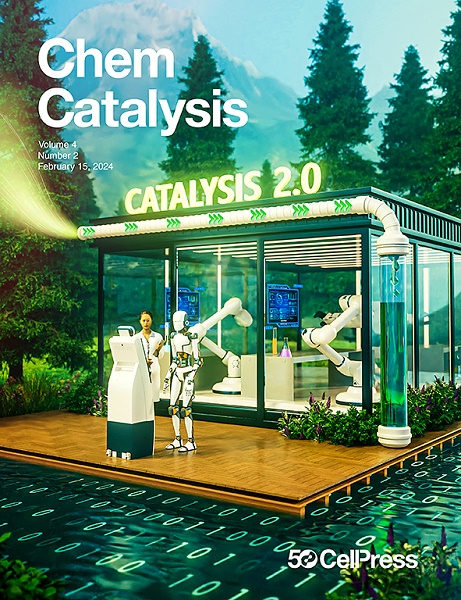模拟环境条件下Au和锐钛矿- tio2界面上的电子存储
IF 11.6
Q1 CHEMISTRY, PHYSICAL
引用次数: 0
摘要
负载在TiO2上的Au是一种很有前途的光催化剂,因为它能够在光照下催化反应,并在黑暗中储存电子以保持反应活性。利用密度泛函理论(DFT)研究了Au/锐钛矿- tio2(001)界面在实际条件下的结构演化和反应性。相图和电荷分析表明,负载在TiO2 (Au/TiO2)界面上的Au纳米粒子通过氧化和还原在不同的电荷状态和结构之间转换,可以可逆地存储电子。这种电子存储和相关的还原电位,以及原子排列,促进了关键的光电化学反应,如氧还原反应(ORR)和CO2还原反应(CO2RR)。晶格钛和氧空位作为活性位点,由于质子耦合电子转移势垒较低,双电子(2e)-ORR途径(H2O2形成)在动力学上受到青睐。该界面还促进了二氧化碳的活化,这在裸金上是一个挑战。这些发现为优化Au/TiO2复合材料的能量存储和转换提供了基础。本文章由计算机程序翻译,如有差异,请以英文原文为准。
Modeling electron storage at the interface between Au and anatase-TiO2 under ambient conditions
Au supported on TiO2 is a promising photocatalyst due to its ability to catalyze reactions under illumination and store electrons for sustained reactivity in the dark. Using density functional theory (DFT), we investigate the structural evolution and reactivity of the Au/anatase-TiO2(001) interface under realistic conditions. Phase diagrams and charge analysis reveal that the Au nanoparticles supported on TiO₂ (Au/TiO2) interface can reversibly store electrons by transitioning between different charge states and structures via oxidation and reduction. This electron storage and the associated reducing potential, along with the atomic arrangement, promote key photoelectrochemical reactions, such as the oxygen reduction reaction (ORR) and the CO2 reduction reaction (CO2RR). Lattice titanium and oxygen vacancies act as active sites, with the two-electron (2e)-ORR pathway (H2O2 formation) kinetically favored due to a lower proton-coupled electron transfer barrier. The interface also facilitates CO2 activation, which is challenging on bare Au. These findings provide a foundation for optimizing Au/TiO2 composites for energy storage and conversion.
求助全文
通过发布文献求助,成功后即可免费获取论文全文。
去求助
来源期刊
CiteScore
10.50
自引率
6.40%
发文量
0
期刊介绍:
Chem Catalysis is a monthly journal that publishes innovative research on fundamental and applied catalysis, providing a platform for researchers across chemistry, chemical engineering, and related fields. It serves as a premier resource for scientists and engineers in academia and industry, covering heterogeneous, homogeneous, and biocatalysis. Emphasizing transformative methods and technologies, the journal aims to advance understanding, introduce novel catalysts, and connect fundamental insights to real-world applications for societal benefit.

 求助内容:
求助内容: 应助结果提醒方式:
应助结果提醒方式:


